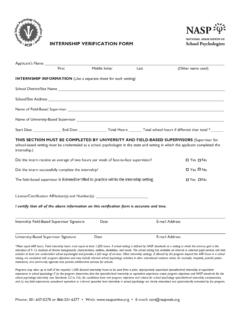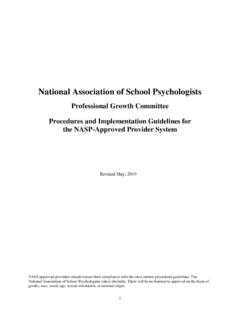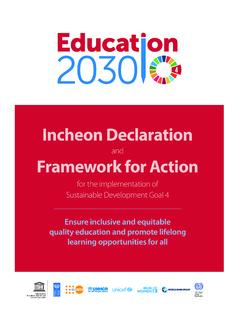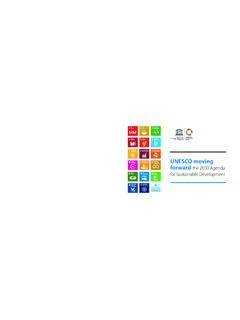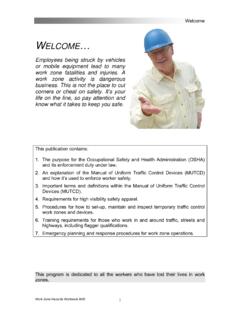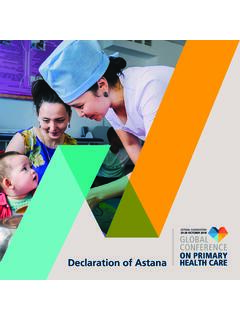Transcription of Early Childhood Disabilities and Special Education
1 Early Childhood Disabilities andSpecial EducationBY KRISTINE SLENTZ, PHD,Western Washington University, BellinghamThe earliest years of life are full of rapid changes and transitions. Youngchildren are all precious, especiallyto their caregivers, regardless of challenges to health, learning, and/or development that are common priorto school entry. Parents and Early Childhood teachers are usually the first to notice when infants, toddlers,and preschoolers are not developing and learning as expected. Parents andteachers are also in the bestposition to provide additional support and Special care when it is is not always a cleardifference, however, between the usual ups and downs of the Early Childhood years and developmentalproblems that indicate a need for Special and toddlers generally acquire developmental milestones in a typical sequence, but no twodevelop at exactly the same rate or following the same patterns.
2 Caregivers often wonder how to tell thedifference between a child s unique timetable and a developmental problem. For example, most infantscrawl before they walk, but some do not. A few take their first steps at 8 months and others not until 15months. Many infants begin to use words around their first birthday, but others begin talking much and other caregivers often understand toddler speech that soundslike gibberish to preschool children are learning to get along socially, to share and take turns and use inside voices,but some are unusually shy or overly aggressive. Both teachers and parentsare familiar with commontroublesome behaviors such as interrupting, refusing, tantrumming, hitting, and biting. Most youngchildren quickly learn to replace problem behaviors with socially appropriate ones.
3 Others persist in defiantor inappropriate behavior that has a negative effect on peer and adult relationships. These examplesclearly illustrate the vast amount of variation among typically developing children. The hard questionsteachers and caregivers sometimes face include:At what point does an individual difference in the rate,sequence, or pattern of Early development indicate a problem? When do the common problems of Early childhoodbecome serious enough to require Special services?WHAT IS A DISABILITY?The concept of disability has many definitions and components, all of which sort children into two groups:those who have Disabilities and those who do not. In reality, applying the concept of disability to earlydevelopment can be confusing.
4 Some children receive disability diagnoses as newborns, althoughdevelopmental and learning problems may not become evident for some , parents andteachers often have concerns about the development and learning ability of some children long before adisability is definitions for disability include words such asincapacity, disadvantage, andhandicap, andindicate that disability has a negative effect on health, development, and/or learning. Medical definitionsinclude diagnoses such asDown syndrome, cerebral palsy, Fragile X syndrome, traumatic brain injury,andspina bifida. Such labels refer to specific conditions that compromise a child s ability to interact, move,grow, and/or learn at expected rates and in typical sequences. This handout addresses Early disabilitiesand Special Education services that address Early developmental and learning needs in very young 2004A federal law entitled Individuals with Disabilities Education Improvement Act (IDEA 2004) provides eligiblechildren, starting at age 3, the right to Special Education services in public schools.
5 Preschool childrenages 3 to 5 are served under Part B of IDEA, which addresses assessment, individualized programs, andplacements for 3- to 21-year-olds. Some states also provide Special Education services to infants and toddlersHelping Children at Home and School III|S8H14 1under Part C of the same law. IDEA identifies specificdisability categories such asorthopedicandother healthimpairments,specific learning Disabilities , autism, blindnessand deafness, andmental state definesdisability to reflect health, learning, and developmentalproblems that can be addressed by Special Education . Tobe eligible for Special Education services, a child musthave a disability that meets the state s definition for atleast one of the IDEA categories and must also needspecial , toddlers, and preschoolers are most ofteneligible under the broad disability category ofdevel-opmental delaybecause eligibility criteria for a morespecific disability category tend to be unreliable orinappropriate for very young children.
6 State definitionsvary somewhat, but in general a developmental delay isconsidered to be significant disruption in the process ofearly development that is likely to have a negative effect onschool performance. Temporary disruptions (such asillness, moving, or emotional upset) and minor departures(such as walking, talking, or completing toilet training laterthan usual) are usually resolved quickly with no lastingimpact. A developmental delay, on the other hand, carrieslong term implications and the need for Special care andsupport. Developmental delay does not necessarily mean aglobal delay, but is found in one or more of the major areasof development, including physical, cognitive, commun-ication, social emotional, or adaptive SHOULD CAREGIVERS MAKE REFERRALS?All young children are growing and learning new thingseach day.
7 We expect to see changes in what very youngchildren know and are able to do from one week to thenext. For this reason, identification of Disabilities involvescomparisons between each child and his or her peers, aswell as monitoring changes in growth and developmentover time. Caregivers need to be familiar with expectedranges of development in order to know when a childmight be showing signs of a significant delay or to 12 MonthsNewborn infants have small repertoires of simplebehaviors such as looking, sucking, turning eyes andheads, waving arms and legs, cooing, and crying. Mostdisabilities that are identified during infancy involveconditions that have a pervasive effect on health, basicmovement, sight, and/or hearing. Serious Disabilities areoften identified at birth or during first year well-babychecks.
8 Infants should be referred for evaluation if, bytheir first birthdays, they do not:NDevelop consistent sleep/wake patterns and routinesNCalm when familiar caregivers hold, cuddle, and talksoothinglyNMove with symmetry, balance, and coordination inincreasingly upright postures such as sitting, crawling,walkingNChew and swallow a variety of solid foodsNUse sounds and gestures to communicate; combineconsonant and vowel sounds to make words12 Months to 3 YearsBy the time children are 3 years old, they typicallyhave learned the basic skills necessary for independ-ent movement , communication, and social inter- action . Disabilities identified during this periodinvolve conditions that interfere with talking, walking,relating to peers, and using hands.
9 Referrals forspecial services may be appropriate for 3-year-oldswho do not:NUse motor skills in play (running, climbing, jumping)NUse fingers and hands to draw, build block structures,play with small toysNPlay near and with peers; begin pretend playNContinue to increase vocabulary and combine wordsinto increasingly longer sentencesNUse eating utensils, undress and dress themselves,use the toiletNLearn simple concepts (hot/cold; up/down; in/out;big/little)NMatch a variety of actions to appropriate objects inplay (hugging stuffed toys, turning pages of books,putting hat on head, stacking blocks)3 to 5 YearsDuring the preschool years children combine andcoordinate a number of fundamental skills to becomeadept at communicating, moving about, socializing, andlearning new information.
10 Referrals may be in order for6-year-olds who do not:NParticipate in groups; attend to adult leading groups ofchildrenNEngage in cooperative and imaginative play with peersNAsk and answer simple questions; consistently use fullsentencesNUse balanced and coordinated motor skills in physicalplayNShow understanding of print concepts ( reading signs, logos, familiar books; writing notes, lists,labels)NDemonstrate beginning knowledge of letters andnumbersNEat, dress, and toilet independentlyS8H14 2| Early Childhood Disabilities and Special EducationNUse present, past, and future tenses of primarylanguage; use descriptive words (adjectives andadverbs)It is important to consider the child s learningexperiences when determining if preschoolers are trulyhaving difficulty with these skills .




